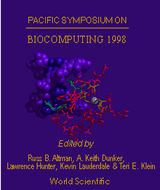Genomic regulation modeled as a network with basins of attraction
Wuensche A
Santa Fe Institute, New Mexico 87501, USA. wuensch@santafe.edu
Pac Symp Biocomput. 1998;:89-102.

Abstract
Many natural processes consist of networks of interacting elements which affect each other's state over time, the dynamics depending on the pattern of connections and the updating rules for each element. Genomic regulatory networks are arguably networks of this sort. An attempt to understand genomic networks would benefit from the context of a general theory of discrete dynamical networks which is currently emerging. A key notion here is global dynamics, whereby state-space is organized into basins of attraction, objects that have only recently become accessible by computer simulation of idealized models, in particular "random Boolean networks". Cell types have been explained as attractors in genomic networks, where the network architecture is biased to achieve a balance between stability and adaptability in response to perturbation. Based on computer simulations using the software Discrete Dynamics Lab (DDLab), these ideas are described, as well as order-chaos measures on typical trajectories that further characterize network dynamics.
[Full-Text PDF] [PSB Home Page]